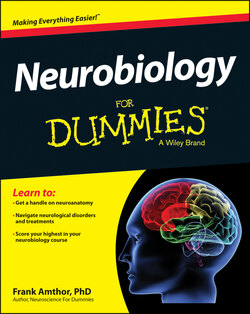Читать книгу Neurobiology For Dummies - Frank Amthor - Страница 3
Neurobiology For Dummies® To view this book's Cheat Sheet, simply go to www.dummies.com and search for “Neurobiology For Dummies Cheat Sheet” in the Search box. Table of Contents
Оглавление1 Cover
2 Title Page
3 Copyright Page
4 Introduction About This Book Foolish Assumptions Icons Used in This Book Beyond the Book Where to Go from Here
5 Part I: Getting Started with Neurobiology Chapter 1: Welcome to the World of Neurobiology Introducing Neurons Organizing the Nervous System Perceiving the World, Thinking, Learning, and Remembering Developmental, Neurological, and Mental Disorders and Treatments Chapter 2: Building Neurons from Molecules Getting into Genetics Meeting Cell Molecules: Important Ions and Proteins Peeking at the Parts of a Cell Setting Boundaries: Cell Membrane Lipids Regulating Water and Cell Volume Knowing the Neuron: Not Just Another Cell When Things Go Wrong: Genetics and Neurological Illness Chapter 3: Gating the Membrane: Ion Channels and Membrane Potentials Looking at Membrane Channels Getting a Charge Out of Neurons Pumping Ions for Information Discovering Diffusion and Voltage Signaling with Electricity in Neurons Making Spikes with Sodium and Potassium Channels Insulating with Glial Cells Chapter 4: Sending Signals: Chemical Release and Electrical Activation Looking at Synaptic Transmission Being Receptive to Neurotransmitter Receptors Dividing and Conquering: Interneurons and Circuits
6 Part II: Neuroanatomy: Organizing the Nervous System Chapter 5: Movement Basics: Muscles and Motor Neurons Making a Move: Muscle Types and What They Do Pulling Your Weight: How Muscle Cells Contract Controlling Muscle Contraction Knowing Where Your Limb Is Located Reflexing without Reflecting Exercise and Aging Chapter 6: The Spinal Cord and the Autonomic Nervous System Segmenting the Spine Spying on the Spinal Cord Feeling and Acting: The Peripheral Nervous System Correcting Errors: The Cerebellum Fighting or Fleeing: The Autonomic Nervous System Chapter 7: The Busy Brain: Brainstem, Limbic System, Hypothalamus, and Reticular Formation The Brainstem: Medulla, Pons, Midbrain Counting the Cranial Nerves Controlling Your Motives: The Limbic System Regulating the Autonomic Nervous System: The Hypothalamus Reading Up on the Reticular Formation Chapter 8: Generating Behavior: Basal Ganglia, Thalamus, Motor Cortex, and Frontal Cortex The Basal Ganglia and Its Nuclei Controlling Muscles: The Primary Motor Cortex Coordinating Muscle Groups: Central Control The Thalamus: Gateway to the Neocortex Focusing on Goals with the Prefrontal Cortex Knowing, or Not Knowing, Who’s In Control Chapter 9: Topping It Off: The Neocortex Looking Inside the Skull: The Neocortex and Its Lobes Getting to the Brain You Have Today: The Neocortex versus Your Reptilian Brain Making Decisions: The Lateral Prefrontal Cortex Doing the Right Thing Seeing Both Sides: The Left and Right Hemispheres Gender and the Brain
7 Part III: Perceiving the World, Thinking, Learning, and Remembering Chapter 10: Looking at Vision and Hearing Imaging and Capturing Light: Vision Joining the Nervous System: Photoreceptor Output Sending the Message to the Brain Fanning Out in the Occipital Lobe Streaming the Message to the Temporal and Parietal Lobes Listening In: Capturing Sound Waves Channeling Sounds to the Brain Losing Hearing Balancing via the Vestibular System: “Hearing” the Fluid Sloshing in Your Head Chapter 11: Feeling, Smelling, and Tasting Getting in Touch with the Skin Recognizing What We Touch at Somatosensory Cortex Sniffing Out the World around You Tasting Basics: Sweet, Sour, Salt, and Bitter Receptors Tasting with the Brain Monitoring Internal Body Functions with Internal Chemoreceptors Chapter 12: Memory and Learning Evolving with Adaptation and Instinct Implicit (Non-Declarative) Memory The Long and Short of It: Immediate versus Permanent Memory Memory Mechanisms and Brain Loci Learning by Changing Synaptic Strengths Forgetting It: Amnesia and Other Memory Loss Improving Your Learning Chapter 13: The Frontal Lobes and Executive Brain Reflexes versus Conscious or Goal-Generated Action Deciding How to Do It: The Frontal Lobes and Action Execution Initiating Action in the Basal Ganglia Coordinating through the Supplementary and Premotor Cortices Mirroring Others: Mirror Neurons Chapter 14: Language, Intelligence, Emotions, and Consciousness Adapting Our Brains for Language Following Thought through Sensory Pathways and Hierarchies Speaking Your Mind: Language, Vision, and the Brain Hemispheres Defining Intelligence Emotional Intelligence Understanding Consciousness
8 Part IV: Developmental, Neurological, and Mental Disorders and Treatments Chapter 15: Developing the Brain and Nervous System Dividing and Differentiating after Conception Polarizing the Brain: Ganglia versus Brains Layering the Neocortex Developmental Neural Disorders Chapter 16: Movement Disorders When the Wheels Come Off: Motor Disorders Failing Forces: Muscle Diseases Neuromuscular Junction Disorders Motor Neuron Damage Basal Ganglia and Other Diseases Strokes and Injuries Chapter 17: Brain Dysfunction and Mental Illness Understanding Mental Illness as Neural Dysfunction Exploring the Genetic Causes of Brain Dysfunction Knowing How the Nervous System Can Be Damaged in Utero Mixing Genetic and Developmental Components Eating and Drinking for Brain Function Chapter 18: Making Better Brains Fixing the Brain with Surgery, Electricity, and Magnetism Repairing Brain Damage Brain–Machine Interfaces Augmenting Brain Function Simulating Brain Function on Computers Downloading the Brain
9 Part V: The Part of Tens Chapter 19: The Ten Most Important Brain Circuits The Reticular Formation in the Brainstem The Spinal Reflex The Thalamic Relay to the Cortex Cerebellar Modulation of Motion Sequences Hippocampal Reciprocal Activation with the Cortex The Amygdala Orbitofrontal Cortex Loop The Spinal Pattern Generator The Conscious Triangle: Frontal and Sensory Cortex with the Thalamus The Basal Ganglia Thalamus Loop The Anterior Cingulate and Pulvinar Central Executives Chapter 20: Ten Technologies Revolutionizing Brain Science Optogenetics: Controlling Neurons with Light Transcranial Magnetic Stimulation and Transcranial Direct Current Stimulation Genetic Disease Models: Knockouts and Knockins Brain Imaging: Optical, Magnetic, and Electrical Interfacing Brains with Computers Deep Brain Stimulation Multi-Electrode Array Recording Fluorescence and Confocal Microscopy Advances in Electrophysiological Recording Tissue Culture and Brain Slices
10 Index
11 About the Author
12 Connect with Dummies
13 End User License Agreement
